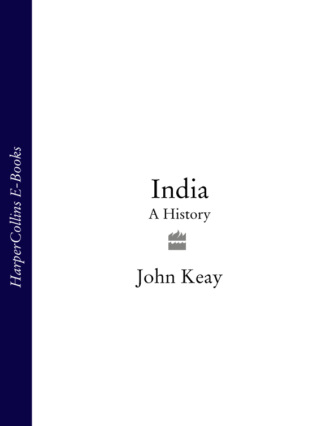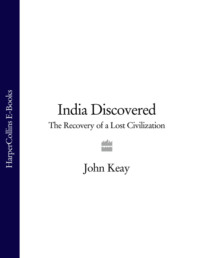
Полная версия
India: A History
This story, though obviously of much later provenance (Shiva was not one of the Vedic gods), well illustrates the importance attached to ritual exactitude. In the Vedas this preoccupation with the precise performance of sacrificial rites extended to minutiae like the orientation of the sacrificial altar and the surgical dissection of the sacrificial victim. Both had scientific repercussions: the positioning of the altar stimulated the study of astronomy and geometry, while dissection encouraged familiarity with anatomy. Similarly that obsession with the ‘word perfect’ recitation of the liturgy would inspire the codification of language and the study of phonetics and versification for which ancient India is justly famed. To anxieties about the impeccable conduct and the sacred siting of such rituals may also be ascribed early notions about the purity, or polluting effect, of those present. Participants had first to undergo purificatory rites which were more rigorous for those who might, because of their dubious descent or profession, prejudice the occasion. A scheme of graded ritual status thereby arose which, as will be seen, contributed to that hierarchical stratification of society known as caste. Thus to the Vedic rituals may be traced the genesis of some of the most distinctive traits of ancient Indian society, culture and science.
PASTORAL PEOPLES
All this, however, scarcely adds up to a convincing picture of the Vedic world, let alone to any kind of understanding of the historical processes at work within it. Somehow this primitive, or pre-modern, society of tribal herdsmen gradually learned about arable farming, assimilated or repulsed neighbours, discovered new resources, developed better technologies, adopted a settled life, organised itself into functional groups, opened trade links, endorsed frontiers, built cities, and eventually subscribed to the organised structures of authority which we associate with statehood. It all took perhaps a thousand years (1500–500BC), but as to the processes involved and the determining factors, let alone the critical events, the sources are silent. They provide a few cryptic clues but no ready answers; and the historian has first to ask the right questions.
The better to identify these questions, scholars have turned to other disciplines, and particularly to comparative anthropology and the study of pre-modern societies that are less remote from our own experience. Thus tribal structures in Polynesia and South America have provided clues about how kin-based societies may become socially stratified and about how notions of land as property may emerge. From the customs of pastoralist peoples in Africa conclusions have been drawn about the importance of cattle-offerings and gifts as a prestige-generating activity. And from native American customs much has been learned about the economic role of sacrifice. Thus the great Vedic sacrifices have been likened to the potlatch, in which the indigenous inhabitants of north-west America indulged in an extravaganza of consumption designed to burn off any surplus and at the same time enhance the status of the leading kin groups. Indeed the central action of the Mahabharata has been likened to one massive potlatch.
All these examples draw on tribal, or lineage, societies united by a shared ethnicity. If the Vedic arya are to be regarded as united principally by language rather than ethnicity, a comparison might also be made with the pre-modern society of the Scottish Highlands and Islands. The Vedic jana is often translated as the Gaelic ‘clan’ since, like the Highland clan, each jana acknowledged descent from a single ancestor. Thus, just as all MacDonalds claim descent from a Donald of Isla who was a distant descendant of the Irish king ‘Conn of the Hundred Battles’, so the Bharatas, the most prominent of the Rig Vedic jana, claimed descent from Bharata, a distant descendant of Pururavas, grandson of Manu. The jana, like the clan, was further divided into smaller descent groups, or septs, which might break away from the parent clan and adopt the name of their own common ancestor as a patronymic. Real or mythical, these ancestral figures were not, however, necessarily of the same race. Some of the Highland clans were of Norse (Viking) origin and others of Pictish or Irish origin; similarly some of the Vedic jana, like the Yadavas, are thought to have been of dasa origin. Hence too the clearly -dasa names of Su-dasa, a Bharata chief who scored a notable victory over ten rival ‘kings’, and Divo-dasa of the ten horse-sacrifices at Varanasi. All, though, whatever their ethnic origin, and whether Indians or Scots, shared a language (Gaelic/Sanskrit), a social system in which precedence was dictated by birth, and a way of life in which both wealth and prestige were computed in cattle.
In Scotland as in India, the rustling of other clans’ herds constituted both pastime and ritual, with success being an indicator of leadership credentials as well as of divine favour. As with the Vedic rajanya, each Highland chief had his bard whose business it was, like Kakshivant, to extol the might and generosity of his chiefly patron and to harness the forces of magic. His, too, was the job of memorising the clan’s genealogy and recording its achievements in verses that might be easily handed down by word of mouth. In Vedic society the bard was originally the chief’s charioteer. His function was not necessarily hereditary nor exclusively reserved to a particular social group. The author of the Mandala IX of the Rig Veda frankly avows humble origins which would have been anathema in a later caste-ridden society.
A bard am I, my father a leech,
And my mother a grinder of corn,
Diverse in means, but all wishing wealth,
Alike for cattle we strive.
In north-west Scotland as in north-west India, cattle were currency; but land was a common resource, not subject to individual rights of ownership and enjoyed in common by the whole clan and its herds. In Scotland this situation changed only under the pressure of a growing population and after the discovery of the land’s greater potential under a different farming regime – namely wool production. Previously, annual migrations to traditional areas of seasonal pasturage had rendered notions of territory and of frontiers fluid and often meaningless. Allegiance focused not on a geographical region nor on a political institution but exclusively on the descent group of the clan chief. This too changed under the new regime, and the chiefs had to find a new role. Perhaps similar pressures confronted the Vedic jana, and similar adaptations to a new farming regime – namely crop-growing – demanded of the rajanya a more possessive attitude to territory and property.
Such comparisons can, of course, be misleading. Technologies and markets not available to the arya in the second millennium BC had ensured a ready demand for Highland beef in the second millennium AD. Hence burning off the year’s surplus in an orgy of sacrifice, gift-exchange and gargantuan consumption was not a Scottish tradition. Conversely, climatic and geographical factors which made livestock farming the only surplus-creating occupation available to upland agriculturalists in Scotland made it a less suitable occupation in the tropical flood-plains of northern India. Although pastoralism would continue in areas like the west bank of the Jamuna and along the skirts of the Himalayas, the environment of the Ganga plain invited more intensive farming and a more sedentary lifestyle. Reference to other pre-modern societies merely helps to clarify the norms which may have characterised Vedic society, and perhaps to render it more intelligible than does that ‘stupendous mass’ of Vedic hymns.
Конец ознакомительного фрагмента.
Текст предоставлен ООО «ЛитРес».
Прочитайте эту книгу целиком, купив полную легальную версию на ЛитРес.
Безопасно оплатить книгу можно банковской картой Visa, MasterCard, Maestro, со счета мобильного телефона, с платежного терминала, в салоне МТС или Связной, через PayPal, WebMoney, Яндекс.Деньги, QIWI Кошелек, бонусными картами или другим удобным Вам способом.









